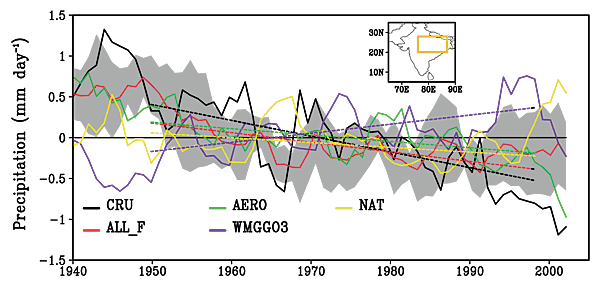Atmospheric Physics, Chemistry & Climate
The Atmospheric Physics, Chemistry and Climate group develops and employs computer models -- alongside a wide range of atmospheric chemical and meteorological measurements -- to advance our understanding of the earth's past, present, and future atmospheric climate and composition.

Radiation
Develop and evaluate shortwave and longwave radiative transfer codes for GFDL models.
Clouds and Convection
Develop parameterizations of convection and stratiform clouds in GFDL atmospheric models.
Aerosol-Cloud Interactions
Employ aerosol and cloud microphysics in General Circulation Models to study the complex interplay among aerosols, clouds and climate.
Tropospheric Aerosols
Develop and evaluate aerosol distributions simulated in GFDL General Circulation Models to better understand their effects on climate and air quality.
Tropospheric Chemistry and Transport
Employ global models to better understand interactions among climate, atmospheric chemistry, and air quality.
Coupled Atmosphere-Ocean-Land Climate Model
Study regional and global climate responses and feedbacks to natural and anthropogenic forcing. Participate in the IPCC Assessment Report 5.
Stratospheric Chemistry and Dynamics
Simulate stratospheric dynamics and chemistry to better understand its coupling to climate. Participate in the WMO Ozone Assessment Report.
Martian Atmospheric Dynamics
Use a dynamical model of the Martian atmosphere to explore fundamental aspects of planetary atmospheric dynamics.
Anthropogenic aerosols and the weakening of the South Asian Summer Monsoon by Bollasina et al., 2011
An important part of the global water cycle, the South Asian summer monsoon provides about 80% of the region’s annual precipitation, and touches the lives of more than 20% of the world’s population. Using the NOAA/GFDL state-of-the-art global climate model that accounts for all the known natural and anthropogenic forcings, we have investigated what caused the observed decrease in the South Asian summer monsoon rainfall over the second half of the 20th century. Was the widespread drying due to natural factors or human activities? (Read more)
The impacts of changing transport and precipitation on pollutant distributions in a future climate by Fang et al., 2011
In order to isolate the
responses of air pollutant transport and wet removal to a warming climate, we
examine a carbon monoxide (CO)–like tracer (COt) and a soluble version (SAt),
in simulations with GFDL AM3 for present (1981-2000) and future (2081-2100)
climates. We find: 1) projected reductions in lower tropospheric ventilation
and wet deposition exacerbate surface air pollution; 2) soluble tracer
increases despite the higher precipitation globally; 3) as large-scale
precipitation dominates wet removal in AM3, its reductions over polluted regions and during polluted seasons contribute
to higher soluble tracer abundance globally in the future. (Read more).
Aerosol effects on stratocumulus water paths in a PDF-based parameterization by Guo et al., 2011
We have incorporated multi-variate probability density functions with dynamics (MVD PDFs) into the single-column model (SCM) of GFDL AM3. In agreement with benchmark large eddy simulations (LESs), our single-column simulations produce both positive and negative liquid water path (LWP) responses to increasing aerosol concentrations. Sensitivity tests show that the dependence of sedimentation on cloud droplet size is essential to capture both the positive and negative LWP responses.
(Read more)
Sensitivity of the aerosol indirect effect to subgrid variability in the cloud parameterization of the GFDL Atmosphere General Circulation Model AM3 by Golaz et al., 2011
We explore the impact of formulation uncertainties related to the representation of clouds in the GFDL general circulation model AM3 by constructing three alternate model configurations. These alternate configurations exhibit only small differences in their present day climatology, but large differences in the magnitude of the aerosol indirect effect.(Read more).
The
dynamical core, physical parameterizations, and basic simulation
characteristics of the atmospheric component AM3 of the GFDL Global
Coupled Model CM3 by Donner et al., 2011

This paper describes the formulation and basic simulation characteristics of the atmospheric component of GFDL's CM3, which will be used extensively in the upcoming Intergovernmental Panel on Climate Change (IPCC) Assessment Report 5. CM3 includes interactions between clouds and aerosols, for the first time in a GFDL climate model. In order to include these interactions, important changes from earlier GFDL climate models include new parameterizations for aerosol activation, deep and shallow convection, and modifications to CM3's macrophysics and microphysics. CM3 also uses a new, highly scalable cubed-sphere finite-volume dynamical core. CM3's aerosol distribution, sea ice, shortwave cloud forcing, and north polar sea level pressure are all improved relative to CM2, which was itself among the best performing models used for IPCC Assessment Report 4.







